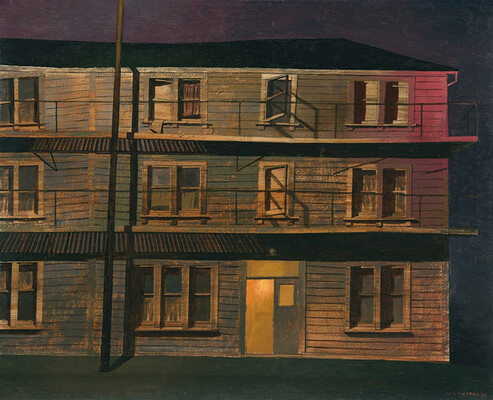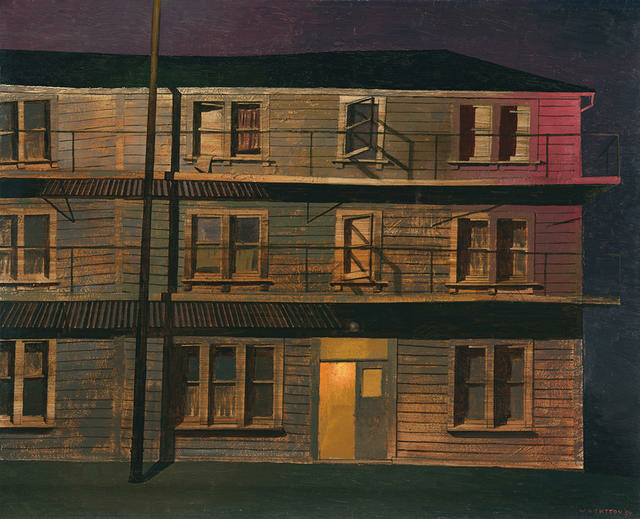B.
Private lodgings by W.A. Sutton
Collection
Private Lodgings is a portrait of a lost Christchurch building that dates most probably from the 1860s.
When Bill Sutton painted it in 1954, it was an increasingly decrepit boarding house, on the corner of Manchester and Southwark streets, just out of the central city - opposite the much more famous Coker's Hotel.
The establishment had formerly been known as the Holmes A1 Temperance Hotel, run by a Mrs Ann Holmes. A temperance hotel provided accommodation and dining but didn't serve alcohol - a place where people who had foresworn drink from their lives might stay.
It was a typical mid-19th century New Zealand hotel building, in timber, occupying a full corner site. Somewhere along the way fire escapes were added to the second and third-storeys.
In the late 1940s, the Temperance Hotel changed hands and became known as the Manchester Private Hotel, offering cheap long-term stays. By the time Sutton painted it, the roof had slumped and the paint was peeling from the walls. The council condemned it in 1963 and it was demolished to make way for a car yard: parts of the building, it was said at the time, were more than 100 years old. In turn, the buildings erected on the site in the 1960s and 70s were demolished after the Christchurch earthquakes. It's an empty lot today.
What I like about this painting apart from its value as a document of a kind of historic building that's largely been lost from Christchurch - is its melancholy mood, which Sutton creates through careful modulation of dark and light. It's got something of an Edward Hopper-esque quality, an air of sadness and mystery about it. The building is full of light, but seemingly empty.
You can't see through its windows; blinds are pulled down and the glass is caked with dirt. At the right, you see the spill of red neon light, perhaps from the Coker's Hotel sign across the road.
It was the first painting of Sutton's acquired for the city's collection. Not an entirely characteristic work by him, it was purchased five years after he returned from London, where he'd studied art after the war. There was quite a period of cultural readjustment for Sutton. "When I arrived back in Christchurch, I nearly went out the other end before I stopped," he said. "The buildings and houses looked as though they were made of cardboard."
Sutton painted Christchurch buildings before and after his trip to Europe: the earlier works are a more tightly controlled record of what he saw, whereas the later works are more abstracted and given expressive qualities. At the same time, he was painting Private Lodgings, he was also working on a series of paintings of country churches - isolated buildings in empty rural landscapes. Both the church works and this one seem to embody a very human sense of loneliness - though there are no people included, you can't help but imagine the stories of those who passed through the building.
This article first appeared as 'Capturing buildings with character' in The Press on 22 March 2016.

